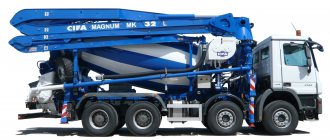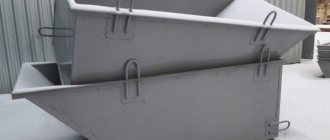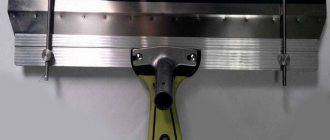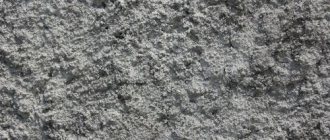A concrete pump is a special device for supplying mortar during the process of pouring buildings and structures, which is very often used on construction sites. In this way, it is possible to significantly improve the quality and productivity of concrete supply by automating part of the process.
Thanks to the concrete pump, the construction mixture is supplied to the pouring site quickly and accurately, the solution can be placed on time (before setting begins), significantly simplifying the processes of preparing, transporting and supplying the material to the construction site. The main advantage of a concrete pump is the ability to quickly remove and pump fresh mixture from a concrete mixer without labor and time.
In addition, the unit is used to supply concrete to a height, which is generally difficult to achieve with manual labor. There are a large number of concrete pumps on the market, which differ in type of installation, operating features, power and performance, and control. And before choosing a specific option, it is advisable to carefully study all the specifications.
Features of application
A concrete pump is usually used when carrying out large-scale construction work using impressive volumes of solutions. The device is especially useful where it is impossible to fit an automixer and where the mixture needs to be fed at a height. Thanks to the use of a pump, it is possible to speed up work and increase labor productivity when pouring/laying the mixture.
In an hour of mechanized work, it is possible to pour many times larger volumes of concrete compared to using conventional methods of supplying them in containers. Due to the fact that a concrete pump is an expensive machine, it is unprofitable to buy a unit for private construction, but for large projects and a large volume of work you cannot do without it. It is possible to rent a pump, which will significantly reduce costs.
At domestic construction sites, concrete pumps are most often used on vehicle platforms of various sizes. If the material needs to be conveyed over a long distance or height, use a special boom.
The operating principle of a concrete pump (and any other) is simple: from the container in which concrete is mixed, the mixture is loaded into the receiving hopper of the pumping device. The solution begins to move forcibly, passing through a pre-installed pipeline. A special boom increases the height/distance that concrete can be conveyed.
Before starting work, it is advisable to pour cement laitance into the pumping mechanism. It lubricates the entire working system, does not allow the unit’s motor to be overloaded, and does not allow air voids in the pipeline.
A concrete pump is a rather complex type of equipment that demonstrates high productivity, but requires professional maintenance.
Specifics of concrete pump application:
- It is necessary to involve highly qualified specialists in the process who know how to work with equipment and concrete in the right rhythm.
- Maximum strict adherence to technologies and rules.
- Proper preparation and organization of the process - concrete is supplied quickly and in large quantities, everything must be done clearly and smoothly.
- Optimal selection of the composition of a special concrete mixture, with mandatory consideration of the diameter of the concrete pump hose, supply distance, supply conditions to the construction site, etc.
Where it is advisable to use a pump for pumping concrete:
- Objects with difficult access for equipment.
- The need to deliver the solution to a height.
- High building density.
- If you have the budget to rent/purchase a unit - in any conditions.
Principle of operation
According to the principle of pumping the finished solution, all concrete pumps are divided into three types: piston, rotary, auger
Piston
The main components of a piston concrete pump are:
- two concrete-feeding cylinders with pistons, the rods of which are connected to hydraulic cylinders,
- bunker for concrete mixture;
- a movable S-shaped gate (valve) driven by two plunger hydraulic cylinders.
Figure 2. Concrete pump structure
Supplying concrete mixture with a piston-type installation consists of the following steps
- Oil is supplied alternately to each of the hydraulic cylinders through the pump station and distributor.
- During one cycle, one of the pistons of the concrete feeding cylinder, moving from the bunker, sucks in the concrete mixture from it, while the second, on the contrary, pushes out the previously collected one.
- A movable gate (valve) connects the cylinder, in which the piston pushes out the poured concrete, with a pipe to which a hose or pipe is connected for supplying the mixture.
The control panel synchronizes the operation of hydraulic cylinders and gate valves.
Rotary
Rotary concrete pumps are units consisting of:
- concrete receiving bunker;
- pressure chamber with a rotating rotor;
- concrete supply line.
Figure 3. Rotary concrete pump
Such units, unlike piston pumps, deliver the concrete mixture more evenly, but at the same time they become very hot and require more careful maintenance.
Screw
Such units with an electromechanical drive supply the concrete mixture thanks to a screw rotating in the pressure chamber.
Figure 4. Screw concrete pump
Due to the low power and limited resource of the working body, such devices are used for small-volume concrete work.
Types of equipment
There are many different types of concrete pumps, differing in characteristics, dimensions, cost, etc. The choice is made based on the conditions, scope of work, budget and basic requirements for the unit.
Stationary
Stationary piston machines require a support with wheels. Relevant for large-scale work, construction of high-rise buildings. The equipment is installed for a long time, starting is carried out by an engine running on diesel fuel or gasoline. A stationary concrete pump can deliver the mixture to considerable heights, providing a capacity of 90 m3/hour.
Concrete can be transmitted over a distance of up to 300 meters. Stationary models have shown themselves to work well with heavy concrete. The main advantages of a permanent installation: the possibility of installation anywhere in the facility, small size, relatively low rental cost.
Trailed
This type of equipment belongs to the category of stationary equipment, since it cannot move independently and requires transportation using a car. The concrete pump is located separately from the car, usually operates under the control of a remote control, powered by an autonomous generator.
Such installations are good for all types of construction sites, fit well into any conditions, and have average power.
Mobile
The concrete pump is attached to the support of a truck specially designed for this purpose. The main advantages of mobile installations: maneuverability, mobility, high power (up to 150 m3/hour), reduction of time for creating various structures.
The pump is already mounted on a vehicle chassis, is usually equipped with a boom with a reach of up to 64 meters, and can change the direction of concrete flow, reducing delays in the process. Typically, this option is chosen for small volumes of concreting with a significant filling area.
The main disadvantage of the installation is its high cost, which makes its purchase justified not for single use, but for continuous operation in construction sites.
Types of cars
A concrete mixer with a pump is a special-purpose vehicle whose task is to deliver concrete to a construction site. Thanks to this, the pouring process is accelerated several times, and the concrete does not have time to lose its properties.
Such machines are quite expensive and it is not practical to buy them for the construction of a small facility. Therefore, today you can find specialized companies engaged in renting out such equipment.
Automixers with a pump are divided into several groups, depending on:
- concrete supply method;
- feed boom length;
- unit power;
- type of autonomy.
The principle of operation of a mixer with a concrete pump Source znaybeton.ru
In turn, the supply method can be:
- Porshnev. In this case, a piston mechanism is used to supply concrete. Such units come with a slide valve and dividing curtain valves.
- Vacuum. The concrete solution is fed into the container using an airless environment that is created here.
According to the method of autonomy, cars are divided into:
- Stationary. The unit is characterized by high power, reliability and the ability to use it even in difficult conditions. But this technique has disadvantages. For example, to deliver it to a construction site you will need a special platform. To supply concrete, a hose wire is provided here, instead of a mounting boom.
- Mobile. The demand for such equipment is maximum. A concrete mixer with a concrete pump is a compact, mobile equipment whose task is to deliver and pump the mixture. They are compact and easy to use, which is why they are in high demand.
Using a concrete mixer with a pump to unload the mixture Source plantas.protexargentina.com
Pump types
The principle of operation of a concrete pump is simple and is based on displacing a mass of mixture. When a free volume of space appears, it is filled again with solution.
According to the type of main working unit of the machine, there are:
- Piston
– can supply concrete at a distance of 6-65 meters vertically, productivity is 180 m3/hour. During the interaction of the pistons and the solution, mixture residues settle on the piston walls, which have an abrasive effect on the mechanism. Therefore, the mass is fed jerkily. There are models with a hydraulic mechanism that are more wear-resistant and provide smooth delivery, as well as high pressure, allowing the mixture to be supplied over much longer distances.
- Screw
– regardless of the hardness of the mixture, the gerotor pump operates quietly. When a blockage appears in the pipeline, the direction of rotation of the motor changes, due to which the blockage is removed. The main disadvantage of this type of machine is the rapid wear of the pipeline. But they are repaired quickly and easily.
As practice shows, gerotor pumps are easier to operate and maintain, but hydraulic ones provide greater performance and durability.
How to make a simple concrete pump
Materials and tools - DIY concrete pump
In the process of making a homemade installation for pumping concrete, the following tools are used:
- welding machine;
- lathe;
- Bulgarian;
- drill;
- screwdriver
set of sockets or wrenches
The following materials are needed to assemble a homemade concrete pump:
- pipe with a diameter of 400-450 mm and a length of at least 800-1000 mm;
- pipe with a diameter of 32-25 mm;
- sheet metal 5 mm thick;
- corner or channel with a wall thickness of 3 mm;
- 3kW asynchronous electric motor;
- actuator;
- power cable with plug;
- flexible reinforced hose with a diameter of 32-40 mm;
- two reed valves with a diameter of 32 mm;
- crankshaft with one connecting rod.
Pump assembly highlights
The manufacturing process of the simplest homemade piston concrete pump consists of the following steps:
- Drawing up a drawing - on paper or in a graphics editor.
- Welding the frame - a rectangular frame measuring 1.5 × 1 m is welded from a strong corner. The frames of single-axle trailers are often used as a frame.
- Making a piston - a round blank is cut out of sheet metal, and two eyes for the connecting rod are welded to the center of it.
- Making a concrete pump chamber cylinder with your own hands, one of the ends of the pipe is hermetically sealed with a round plug made of sheet metal. Using bimetallic round bits, two holes are made on two opposite sides, to which 2-inch threaded pipes are welded. To secure the cylinder to the frame, two plates with holes are welded to it.
- Attaching the valves - a check valve is screwed onto the threaded part of each pipe. In this case, one of them (intake) is installed in such a way that during the reverse stroke of the piston it opens, while the second is closed. A small piece of pipe is screwed into each of the valves, to which reinforced hoses of the suction and concrete supply lines are attached using worm clamps.
- Mounting the electric motor with starter on the frame
- Connection of the electric motor shaft with a reduction gearbox
- Connection of the gearbox output shaft to the short crankshaft
- Making a hinged connecting rod - an extension is attached to a regular short connecting rod that goes along with the crankshaft using a bolt and nut - a rod with a diameter of 12-14 mm with two flattened ends in which holes are drilled.
- Attaching the connecting rod to the piston - the free flattened end of the extension is inserted between the eyes in the center of the piston and secured with a bolt and nut.
At the final stage of assembly, the cylinder with the piston is fixed to the frame, the functionality of the entire assembled unit and its main mechanisms is checked.
Moving concrete
The use of a concrete pump or a stationary version is relevant due to the fact that ready-made concrete cannot stand for a long time and, over time, loses its characteristics. Therefore, where large volumes need to be poured manually, it is simply impossible to prepare the required volume and use it quickly. Thus, supply through a concrete pump becomes the only option for high-quality and quick pouring.
Concrete is delivered to the site in a concrete mixing structure attached to a vehicle chassis. In an iron container, the blades rotate clockwise, moving the solution inward. The reverse process pushes the mixture along the blades towards the discharge opening.
The main advantages of using a mixer:
- The ability to maintain the homogeneity of the solution and avoid delamination of the structure.
- Constant mixing of the mixture, which allows you to maintain all the technical characteristics of the solution even with short delays.
- Preparing the required volume of solution in one portion and maintaining it in optimal condition (which cannot be done manually).
The volume of a mixer barrel is on average 5-9 cubic meters; the machine has a special loading tray for delivering the mixture to the object. To supply directly to the right place, a pipeline is used, which makes it possible to supply the solution horizontally/vertically using one mechanism, to perform work in hard-to-reach places.
Pipeline equipment includes in the category machines for supplying concrete and certain types of construction equipment. Some units of special transport require the installation of a concrete pump on the vehicle base, as well as the use of a full-rotating boom.
Thanks to this technique, it is possible to transport and supply liquid solution in a vertical or horizontal position. Without such units, it is impossible to carry out multi-story construction or supply mortar to hard-to-reach places.
Delivery of solutions in concrete pumps from “Beton Center”
Are you planning construction in Tver or the Tver region? We offer inexpensive rental of a concrete pump in. The company's fleet includes more than 10 units of construction equipment from leading European and Japanese brands. Among them are concrete pumps with boom lengths from 20 to 55 meters.
| The minimum rental period is 1 machine shift (8 hours). The cost of the service is from 20,000 rubles. Overtime work hours are paid additionally. The starting mixture (cement laitance) is included in the price. You can pay for your order in cash or by bank transfer. |
In you can rent reliable special equipment, construction equipment and purchase high-quality concrete mixtures at affordable prices. All products of the plant are subject to mandatory certification.
Call us and your application will be completed within the specified time frame.
Recommendations, tips
In order for work with complex equipment to be high-quality, productive and efficient, the concrete pump must be operated correctly. Usually all the requirements are specified in the instructions, but it is important to remember some rules.
How to use a concrete pump correctly:
- Before starting work, check the unit for the presence of hydraulic pressure, the value of which must be indicated in the technical passport.
- When using a concrete pump, it is important to constantly monitor the operating pressure in the system, adhering to the value specified in the instructions.
- After completing the concrete supply process, the pipeline must be cleaned under pressure with a technical fluid, which is why the installation must be equipped with a pump for pumping out water.
- It is advisable to select a mixture suitable for convenient operation and stable pumping by sampling, preparing compositions of different consistencies (or ordering a solution with exact characteristics from the factory - in Moscow and the region, many manufacturers sell ready-made mixtures).
- It is important to correctly create a route for the passage of the mixture - so that there are a minimum of bends in the pipe. All pipes should be inclined, but without right angles.
- Before transporting the mixture, the concrete pipe must be moistened with cement laitance or lime mortar, which will act as a lubricant for the walls.
- Long interruptions in the supply of concrete mixture are prohibited; in case of production stagnation, the solution is periodically pumped through pipes every 10 minutes at minimum speed.
- The main cause of problems in the operation of the concrete pump and pipeline is blockage of the pump. Usually occurs due to long periods of downtime, too high viscosity of the mixture, during hardening of concrete prepared in violation of the technology.
- If a blockage occurs, the unit must be turned off, the location of the blockage must be found, and the pipeline must be cleaned.
- If the concrete pump is used in winter, it is heated with steam, and the concrete mixture is heated to +20-30 degrees before loading into the machine.
The concrete pump is used very often in a variety of areas of construction, as it allows you to perform assigned tasks quickly, efficiently and with maximum productivity. Most often, such machines are used in the industrial sector, since in private construction they are disproportionately expensive.
Stationary concrete pump
This type includes a conventional concrete pump, which, as a rule, is installed on a platform or truck for the purpose of further movement to the desired location. There can be many options for such devices.
Figure 1. Concrete pump operation diagram.
This design consists of a trailer and chassis, as a result of which concrete is supplied continuously. A stationary concrete pump can be moved by attaching it to another vehicle. The principle of operation of the pump is quite simple: it is continuous pumping of a solution in large quantities. As for the operating modes of the pump, there are only two of them: one with a fairly high pressure, although the productivity in this case is much lower, the second with a pressure of a lower value (here the productivity is much greater than in the previous case). This need is due to the fact that in the process of laying concrete pipes (that is, pipes) at the corners, a sufficiently high pressure in the cylinders is required. This allows the concrete underneath to be raised.











